Do not trust sites offering "Domain name search engine registration"
Phishing/ScamAlso Known As: Domain name search engine registration POP-UP scam
Get free scan and check if your device is infected.
Remove it nowTo use full-featured product, you have to purchase a license for Combo Cleaner. Seven days free trial available. Combo Cleaner is owned and operated by RCS LT, the parent company of PCRisk.com.
What is the "Domain name search engine registration scam"?
"Domain name search engine registration scam" refers to a scheme run on deceptive websites. It has been observed being promoted via spam email campaigns. The scam claims that users must register their websites' domain names and that this registration will ensure the site's validity for promotion on search engines.
This is a bogus service and all of the information provided by the "Domain name search engine registration scam" is false. In addition to requesting payment for fake services, this scheme also has elements of phishing scams. I.e., users are asked to provide their personal information.
Typically, unintentional access to deceptive web pages occurs via mistyped URLs, redirects caused by intrusive advertisements or by Potentially Unwanted Applications (PUAs). This software does not need explicit user permission to be installed onto systems and thus users may be unaware of its presence.
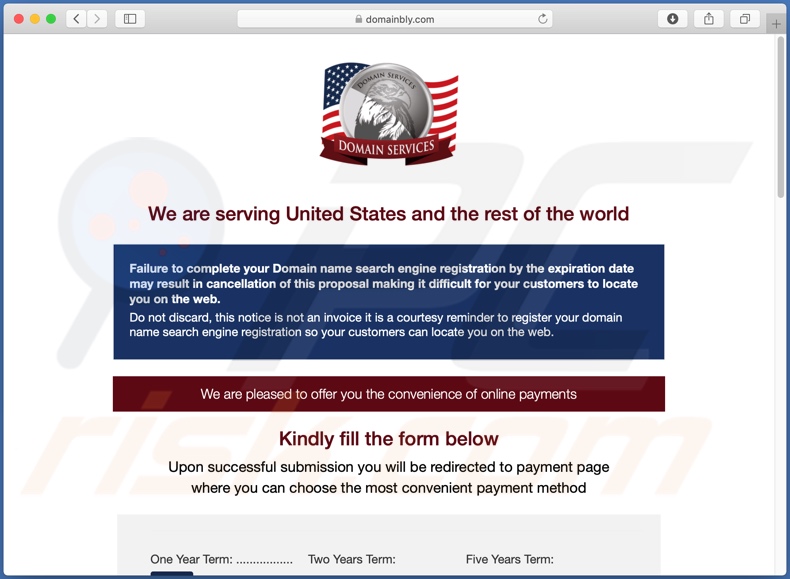
The "Domain name search engine registration scam" states that it is a service offered worldwide, though the scheme also emphasizes the United States of America specifically. This scam informs users that they must complete their website domain name search engine registration.
Failure to comply may result in the unregistered site becoming difficult/impossible to find on the web. The bogus service is priced at: US$75.00 (USD) for a year, US$119.00 for two years, US$199.00 for five, US$295.00 for ten, and US$499.00 for lifetime. Additionally, users are asked to provide the following information: domain name, email address and mobile phone number.
As mentioned, "Domain name search engine registration" is a scam and must not be trusted - any website promoting it should be closed immediately.
Scams that deal with monetary transactions (e.g. accept payments for fake services, etc.) usually employ dubious payment gateways and/or digital currencies (e.g. cryptocurrencies, pre-paid vouchers, gift cards, etc.) to ensure that the payments are difficult/impossible to reverse and trace.
Furthermore, untrustworthy payment gateways commonly operate as phishing websites, which record any information entered into them (e.g. names, addresses, emails, phone numbers, banking account and/or credit card details, etc.).
How phishing sites use the stolen information varies, especially so as the data is typically sold and resold to multiple third parties (possibly, even to cyber criminals). Note that successfully scammed victims are often targeted repeatedly by scammers, either in continuation of the scam or with a new scenario in play.
To summarize, by trusting the "Domain name search engine registration scam", users risk experiencing severe privacy issues, financial losses and even identity theft.
One of the prime causes behind rogue redirects to various untrustworthy, deceptive and malicious websites are PUAs, however, these unwanted applications can have different capabilities and these functions can be in varied combinations. Adware-types deliver intrusive advertisement campaigns.
The delivered ads diminish the browsing experience and, when clicked, redirect to dangerous web pages. Some can even stealthily download/install software. Browser hijackers are another type of PUA, which make alterations to browser settings and restrict/deny access to them to promote fake search engines.
The promoted web searchers are rarely able to provide search results, and so they tend to redirect to Google, Bing, Yahoo and other legitimate search engines. Most PUAs have data tracking capabilities. They monitor browsing activity (browsing and search engine histories) and collect personal information extracted from it (IP addresses, geolocations and other details).
The presence of this unwanted software on systems endangers both device and user safety. Therefore, eliminate all suspicious applications and browser extensions/plug-ins immediately upon detection.
| Name | Domain name search engine registration POP-UP scam |
| Threat Type | Phishing, Scam, Social Engineering, Fraud. |
| Fake Claim | Scam claims users need to register their website domain to ensure its online visibility. |
| Related Domains | domainbly[.]com |
| Detection Names (domainbly[.]com) | Fortinet (Spam), Spamhaus (Spam), Full List Of Detections (VirusTotal). |
| Serving IP Address | 154.16.116.23 |
| Symptoms | Fake error messages, fake system warnings, pop-up errors, hoax computer scan. |
| Distribution methods | Compromised websites, rogue online pop-up ads, potentially unwanted applications. |
| Damage | Loss of sensitive private information, monetary loss, identity theft, possible malware infections. |
| Malware Removal (Windows) |
To eliminate possible malware infections, scan your computer with legitimate antivirus software. Our security researchers recommend using Combo Cleaner. Download Combo CleanerTo use full-featured product, you have to purchase a license for Combo Cleaner. 7 days free trial available. Combo Cleaner is owned and operated by RCS LT, the parent company of PCRisk.com. |
The internet is full of various deceptive web pages, which use likewise varied tactics to gain and abuse users' trust.
Some example of popular scam models include: tech support scams - typically, warnings that the device is infected or at risk (e.g. "Killer's IP Address", "ERROR # 0xuaO-0x156m(3)", "MS-Windows Support Alert", etc.); alerts that a piece of essential software is outdated or missing (e.g. "Adobe Flash Player Update", "Required video codec is not installed on your computer", "To continue, you must perform a manual update", etc.); fake prize raffles (e.g. "Amazon loyalty program", "You've made the 9.68-billionth search", "International Official Lottery", etc.); "unbelievable" deals and offers (e.g. "LiteCoin Giveaway", "BTC giveaway", "Randomly selected to test the new iPhone", etc.), and so on.
Regardless of what these scams claim, offer, request or demand, the purpose is identical: to generate revenue for the scammers/cyber criminals behind them.
How did potentially unwanted applications install on my computer?
PUAs are often downloaded/installed together with other products. This deceptive marketing technique of pre-packing regular software with unwanted or malicious additions is called "bundling".
By rushing through download/installation of software (e.g. ignoring terms, skipping steps and sections, using "Quick/Express" settings, etc.) many users risk unintentionally allowing bundled content into their devices. Intrusive advertisements proliferate PUAs as well.
When clicked, the ads can execute scripts to download/install these applications without users' permission. Some PUAs have "official" download web pages from which they can be downloaded.
How to avoid installation of potentially unwanted applications
You are advised to research all software before download/installation. Use only official and verified download channels. Unofficial and free file-hosting websites, Peer-to-Peer sharing networks (BitTorrent, Gnutella, eMule), and other third party downloaders commonly offer harmful and bundled content, and are therefore untrusted and should be avoided.
When downloading/installing, read the terms, study all possible options, use the "Custom/Advanced" settings and opt-out of additional apps, tools, features, and so on. Intrusive advertisements typically seem legitimate, however, they can redirect to dubious and malicious sites (e.g. gambling, pornography, adult-dating, and many others).
If you encounter ads or redirects of this kind, inspect the system and remove all dubious applications and browser extensions/plug-ins immediately. If your computer is already infected with PUAs, we recommend running a scan with Combo Cleaner Antivirus for Windows to automatically eliminate them.
Text presented in the "Domain name search engine registration scam" website:
We are serving United States and the rest of the world
Failure to complete your Domain name search engine registration by the expiration date may result in cancellation of this proposal making it difficult for your customers to locate you on the web.Do not discard, this notice is not an invoice it is a courtesy reminder to register your domain name search engine registration so your customers can locate you on the web.
We are pleased to offer you the convenience of online payments
Kindly fill the form below
Upon successful submission you will be redirected to payment page where you can choose the most convenient payment method
One Year Term: .................$75.00
Two Years Term: .................$119.00
Five Years Term: .................$199.00
Ten Years Term: .................$295.00
Lifetime Term: .................$499.00
Domain Name (which is the same as your website address):
Email:
Confirm Email:
Mobile Phone:
City:
Signature:Sign with your mouse or if you are using a phone sign using touch screen
* fields in red fonts have errors
Submit
Click submit only once, it may take up to 60 seconds to process your request.
Note :
By clicking submit or proceeding further you confirm and agree to our Terms and Privacy Policy.
Having troubles submitting the form ? Click here to proceed further!
Copyright @ 2012 Domain Services, All Rights Reserved
Home | Terms of Use | Privacy Policy | Contact Us
If you do not wish to receive any further notifications from us or our marketing company, please unsubscribe here.
Appearance of the "Domain name search engine registration scam" (GIF):
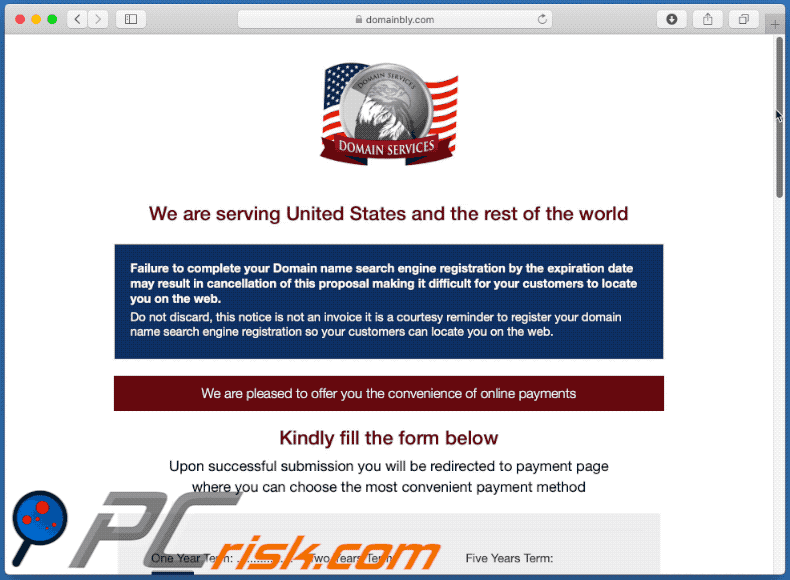
Screenshot of a phishing email promoting the website running "Domain name search engine registration scam":
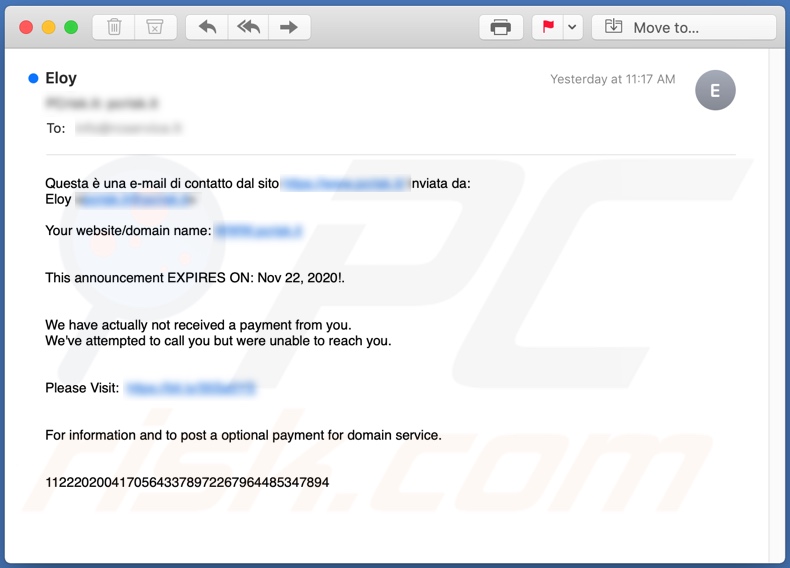
Text presented in this scam email:
Questa è una e-mail di contatto dal sito ******** inviata da:
Eloy
Your website/domain name: ********
This announcement EXPIRES ON: Nov 22, 2020!.
We have actually not received a payment from you.
We've attempted to call you but were unable to reach you.
Please Visit: ********
For information and to post a optional payment for domain service.
11222020041705643378972267964485347894
Instant automatic malware removal:
Manual threat removal might be a lengthy and complicated process that requires advanced IT skills. Combo Cleaner is a professional automatic malware removal tool that is recommended to get rid of malware. Download it by clicking the button below:
DOWNLOAD Combo CleanerBy downloading any software listed on this website you agree to our Privacy Policy and Terms of Use. To use full-featured product, you have to purchase a license for Combo Cleaner. 7 days free trial available. Combo Cleaner is owned and operated by RCS LT, the parent company of PCRisk.com.
Quick menu:
- What is "Domain name search engine registration scam"?
- STEP 1. Uninstall deceptive applications using Control Panel.
- STEP 2. Remove rogue extensions from Google Chrome.
- STEP 3. Remove potentially unwanted plug-ins from Mozilla Firefox.
- STEP 4. Remove rogue extensions from Safari.
- STEP 5. Remove rogue plug-ins from Microsoft Edge.
- STEP 6. Remove adware from Internet Explorer.
Removal of potentially unwanted applications:
Windows 11 users:

Right-click on the Start icon, select Apps and Features. In the opened window search for the application you want to uninstall, after locating it, click on the three vertical dots and select Uninstall.
Windows 10 users:

Right-click in the lower left corner of the screen, in the Quick Access Menu select Control Panel. In the opened window choose Programs and Features.
Windows 7 users:

Click Start (Windows Logo at the bottom left corner of your desktop), choose Control Panel. Locate Programs and click Uninstall a program.
macOS (OSX) users:

Click Finder, in the opened screen select Applications. Drag the app from the Applications folder to the Trash (located in your Dock), then right click the Trash icon and select Empty Trash.
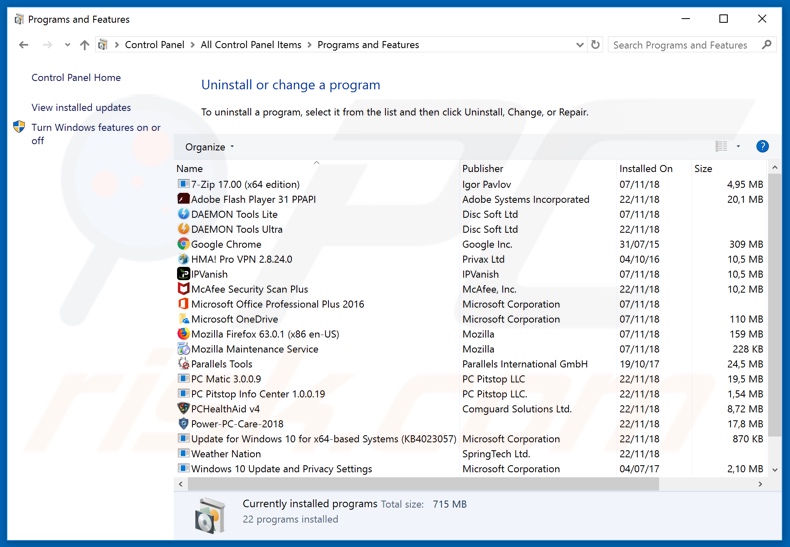
In the uninstall programs window, look for any suspicious/recently-installed applications, select these entries and click "Uninstall" or "Remove".
After uninstalling the potentially unwanted application, scan your computer for any remaining unwanted components or possible malware infections. To scan your computer, use recommended malware removal software.
DOWNLOAD remover for malware infections
Combo Cleaner checks if your computer is infected with malware. To use full-featured product, you have to purchase a license for Combo Cleaner. 7 days free trial available. Combo Cleaner is owned and operated by RCS LT, the parent company of PCRisk.com.
Remove rogue extensions from Internet browsers:
Video showing how to remove potentially unwanted browser add-ons:
 Remove malicious extensions from Google Chrome:
Remove malicious extensions from Google Chrome:
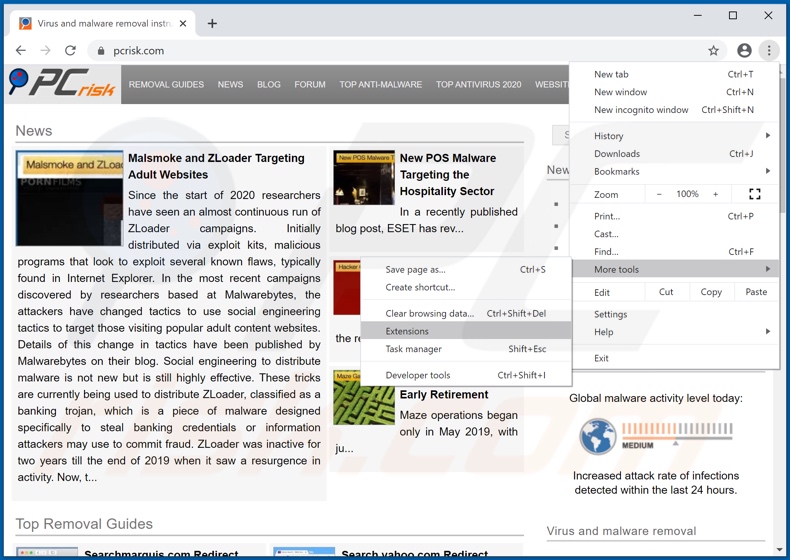
Click the Chrome menu icon ![]() (at the top right corner of Google Chrome), select "More tools" and click "Extensions". Locate all recently-installed suspicious browser add-ons and remove them.
(at the top right corner of Google Chrome), select "More tools" and click "Extensions". Locate all recently-installed suspicious browser add-ons and remove them.
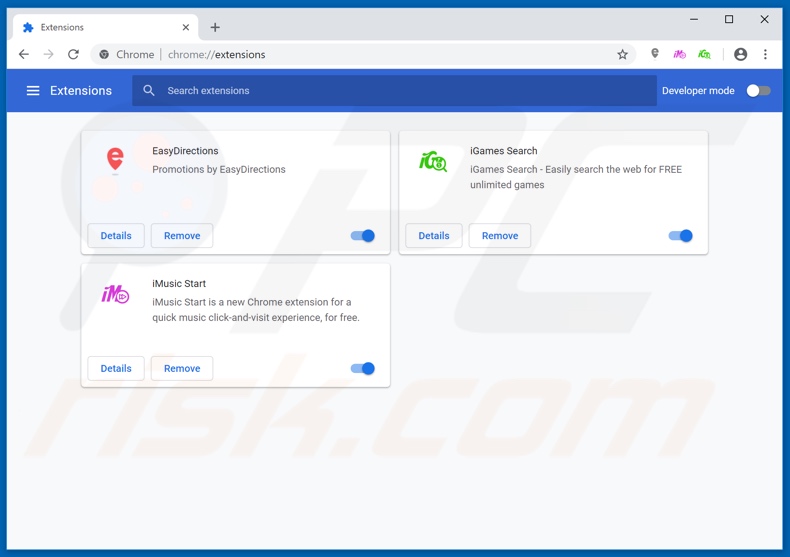
Optional method:
If you continue to have problems with removal of the domain name search engine registration pop-up scam, reset your Google Chrome browser settings. Click the Chrome menu icon ![]() (at the top right corner of Google Chrome) and select Settings. Scroll down to the bottom of the screen. Click the Advanced… link.
(at the top right corner of Google Chrome) and select Settings. Scroll down to the bottom of the screen. Click the Advanced… link.

After scrolling to the bottom of the screen, click the Reset (Restore settings to their original defaults) button.

In the opened window, confirm that you wish to reset Google Chrome settings to default by clicking the Reset button.

 Remove malicious plug-ins from Mozilla Firefox:
Remove malicious plug-ins from Mozilla Firefox:
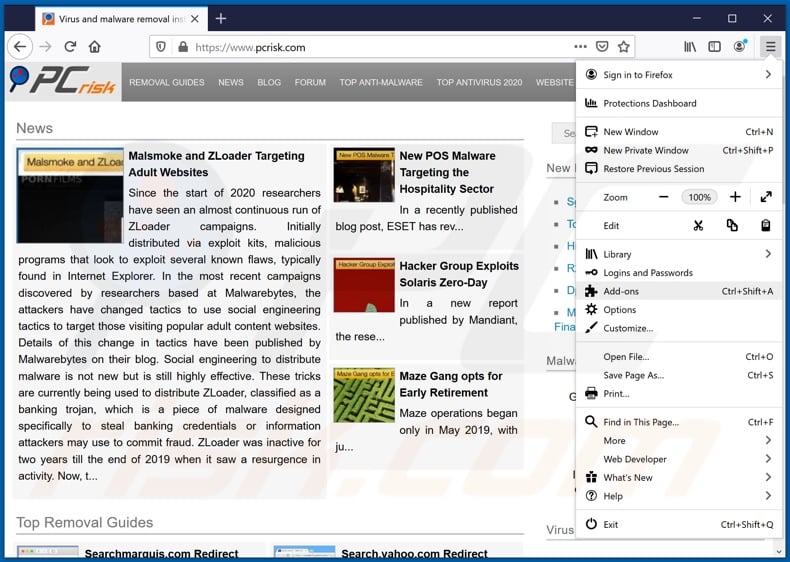
Click the Firefox menu ![]() (at the top right corner of the main window), select "Add-ons". Click on "Extensions", in the opened window remove all recently-installed suspicious browser plug-ins.
(at the top right corner of the main window), select "Add-ons". Click on "Extensions", in the opened window remove all recently-installed suspicious browser plug-ins.
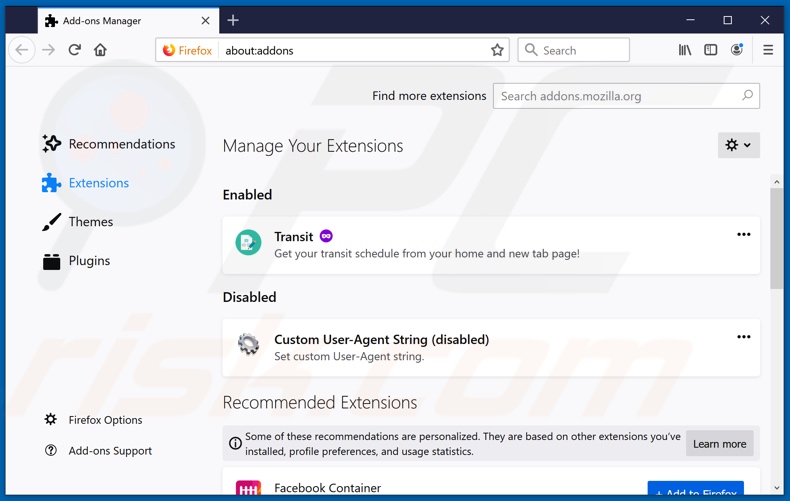
Optional method:
Computer users who have problems with domain name search engine registration pop-up scam removal can reset their Mozilla Firefox settings.
Open Mozilla Firefox, at the top right corner of the main window, click the Firefox menu, ![]() in the opened menu, click Help.
in the opened menu, click Help.

Select Troubleshooting Information.

In the opened window, click the Refresh Firefox button.

In the opened window, confirm that you wish to reset Mozilla Firefox settings to default by clicking the Refresh Firefox button.

 Remove malicious extensions from Safari:
Remove malicious extensions from Safari:

Make sure your Safari browser is active, click Safari menu, and select Preferences....

In the opened window click Extensions, locate any recently installed suspicious extension, select it and click Uninstall.
Optional method:
Make sure your Safari browser is active and click on Safari menu. From the drop down menu select Clear History and Website Data...

In the opened window select all history and click the Clear History button.

 Remove malicious extensions from Microsoft Edge:
Remove malicious extensions from Microsoft Edge:

Click the Edge menu icon ![]() (at the upper-right corner of Microsoft Edge), select "Extensions". Locate all recently-installed suspicious browser add-ons and click "Remove" below their names.
(at the upper-right corner of Microsoft Edge), select "Extensions". Locate all recently-installed suspicious browser add-ons and click "Remove" below their names.

Optional method:
If you continue to have problems with removal of the domain name search engine registration pop-up scam, reset your Microsoft Edge browser settings. Click the Edge menu icon ![]() (at the top right corner of Microsoft Edge) and select Settings.
(at the top right corner of Microsoft Edge) and select Settings.

In the opened settings menu select Reset settings.

Select Restore settings to their default values. In the opened window, confirm that you wish to reset Microsoft Edge settings to default by clicking the Reset button.

- If this did not help, follow these alternative instructions explaining how to reset the Microsoft Edge browser.
 Remove malicious add-ons from Internet Explorer:
Remove malicious add-ons from Internet Explorer:
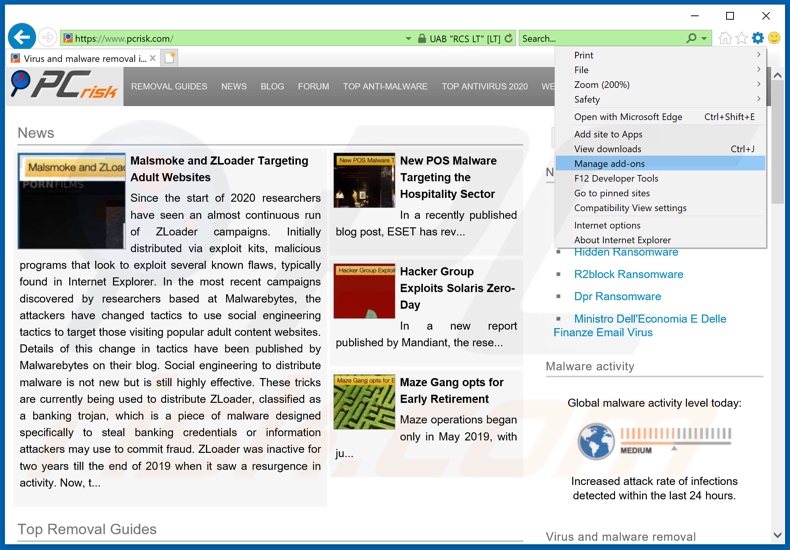
Click the "gear" icon ![]() (at the top right corner of Internet Explorer), select "Manage Add-ons". Look for any recently-installed suspicious browser extensions, select these entries and click "Remove".
(at the top right corner of Internet Explorer), select "Manage Add-ons". Look for any recently-installed suspicious browser extensions, select these entries and click "Remove".
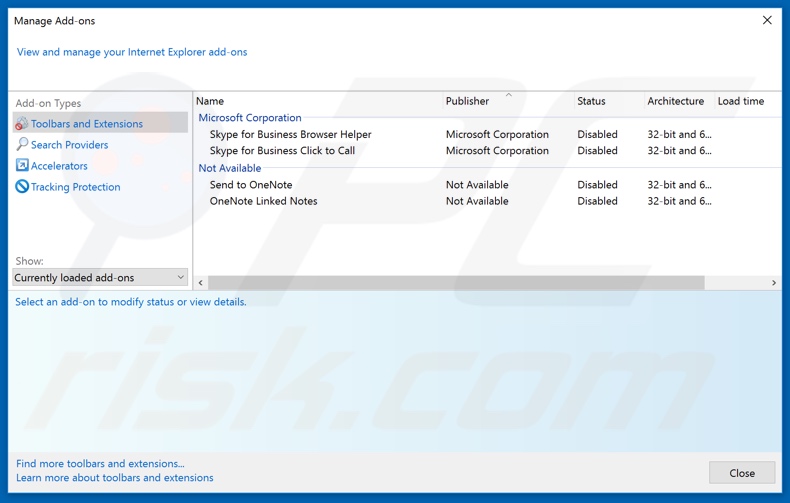
Optional method:
If you continue to have problems with removal of the domain name search engine registration pop-up scam, reset your Internet Explorer settings to default.
Windows XP users: Click Start, click Run, in the opened window type inetcpl.cpl In the opened window click the Advanced tab, then click Reset.

Windows Vista and Windows 7 users: Click the Windows logo, in the start search box type inetcpl.cpl and click enter. In the opened window click the Advanced tab, then click Reset.

Windows 8 users: Open Internet Explorer and click the gear icon. Select Internet Options.

In the opened window, select the Advanced tab.

Click the Reset button.

Confirm that you wish to reset Internet Explorer settings to default by clicking the Reset button.

Summary:
 Commonly, adware or potentially unwanted applications infiltrate Internet browsers through free software downloads. Note that the safest source for downloading free software is via developers' websites only. To avoid installation of adware, be very attentive when downloading and installing free software. When installing previously-downloaded free programs, choose the custom or advanced installation options – this step will reveal any potentially unwanted applications listed for installation together with your chosen free program.
Commonly, adware or potentially unwanted applications infiltrate Internet browsers through free software downloads. Note that the safest source for downloading free software is via developers' websites only. To avoid installation of adware, be very attentive when downloading and installing free software. When installing previously-downloaded free programs, choose the custom or advanced installation options – this step will reveal any potentially unwanted applications listed for installation together with your chosen free program.
Post a comment:
If you have additional information on domain name search engine registration pop-up scam or it's removal please share your knowledge in the comments section below.
Share:

Tomas Meskauskas
Expert security researcher, professional malware analyst
I am passionate about computer security and technology. I have an experience of over 10 years working in various companies related to computer technical issue solving and Internet security. I have been working as an author and editor for pcrisk.com since 2010. Follow me on Twitter and LinkedIn to stay informed about the latest online security threats.
PCrisk security portal is brought by a company RCS LT.
Joined forces of security researchers help educate computer users about the latest online security threats. More information about the company RCS LT.
Our malware removal guides are free. However, if you want to support us you can send us a donation.
DonatePCrisk security portal is brought by a company RCS LT.
Joined forces of security researchers help educate computer users about the latest online security threats. More information about the company RCS LT.
Our malware removal guides are free. However, if you want to support us you can send us a donation.
Donate
▼ Show Discussion